Genetics – DNA – Colour Matches
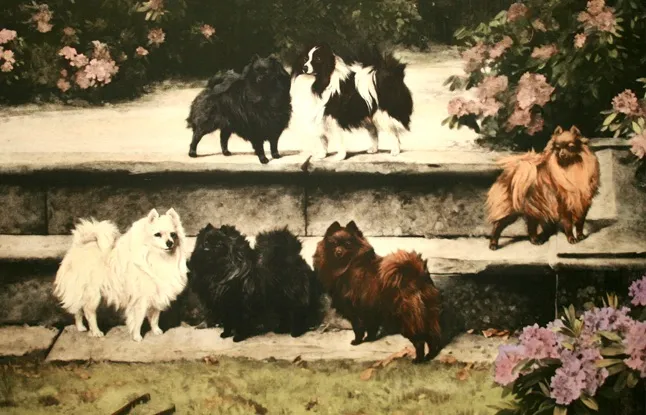
” collection of an old engraving of Pomeranian champions in England 100 years ago, entitled “Pomeranians of the 20th century”. They are labelled Haughty Winnie and Magpie in first place and Little Ladysmith, Arcadia Page of Kent, Ch Haughty Prince and Monmouth Ruffle in second place. Please note that they come exclusively in Dark, White, Chocolate and Partis”:
cantonpomeranians.com
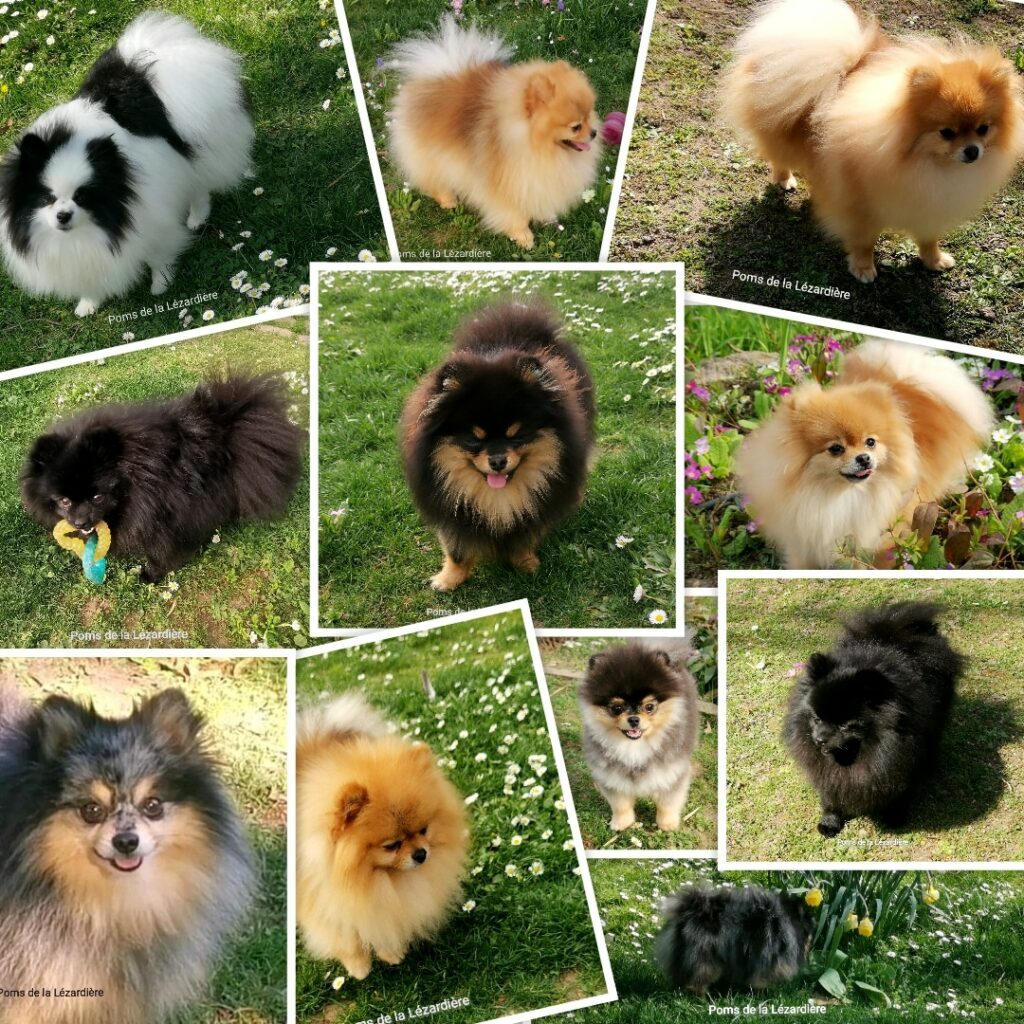
I – Understanding genetics
1 – What is DNA? a gene? a chromosome?
2 – The canine genome
II – Dog DNA
1 – the genetics of colours explained in photos
2 – The different locus
3 – The marble colour
III – Guidelines on colour matching
IV – Going further
1 – E-learning modules with the Centrale Canine
2 – Understanding the mechanism that governs heredity and genetic phenomena
V – In videos
In this new chapter I will try to explain genetics, that the colour of the dog is expressed through its DNA and that the colour code is composed of Locus.
Let’s try to understand how this works.
We will see which marriages are possible and authorised in France, but also which ones are not.
We’ll finish with a few videos to give you a better understanding.
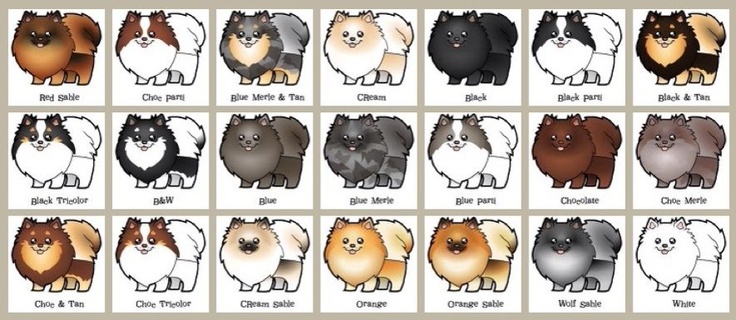
I – Understanding genetics
The sum of a dog’s genetic material can be seen as a cookbook divided into chapters containing recipes.
These recipes are the dog’s genes and the letters that make up each recipe are its DNA. Just as a recipe can be used to make a dish of food, a gene can be used to make a protein, a building block of a dog’s body.
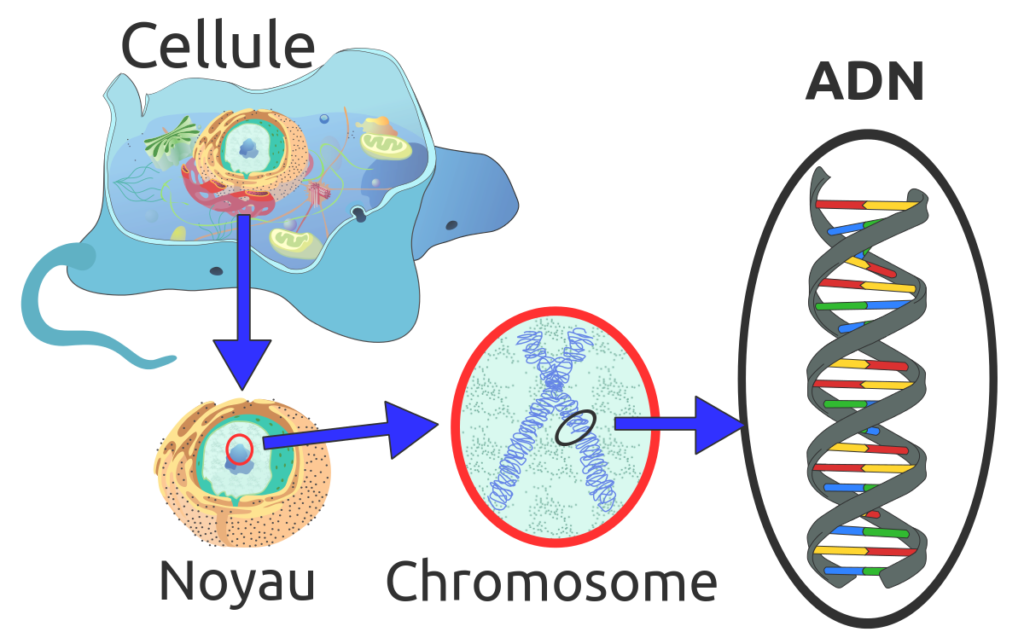
1 – What is DNA?
DNA, or deoxyribonucleic acid, is found in all known living things and acts as a set of biological instructions. These instructions make each breed, species and dog (with the exception of identical siblings) unique. DNA is found in almost every cell in the body, with the exception of red blood cells, and tells a dog’s body how to grow, develop, function and reproduce.
How are the genetic instructions of a dog stored?
A dog’s genetic instructions are stored as a type of code consisting of units called bases. There are four different bases in DNA and they are called adenine (A), guanine (G), cytosine (C) and thymine (T).
Each base unit is linked to a sugar molecule and a phosphate molecule, thus forming a string of bases. Just as a sequence of letters can be used to form words and words to form sentences, the base sequences on the chain can also be used to produce the proteins that make up each organism. Proteins are the building blocks of every organism and make up bones, teeth, hair, muscles, etc.
The structure of DNA
Two complementary chains of bases run parallel to each other and lock together to form a spiral staircase-like structure called a double helix. The bases of each of the two ropes come together to form the “steps” of the structure. Each base will only bind to a specific partner base, for example adenine always binds to thymine and cytosine always binds to guanine. This feature of DNA is particularly important when it comes to producing new cells with the same DNA, which is vital for growth, maintenance and repair. When cells divide, the double helix structure decompresses, releasing each of the two base chains to bind to another set of bases, producing two copies of the original DNA.
The dog genome (the sum of its genetic material) contains 2.8 billion base pairs of DNA.
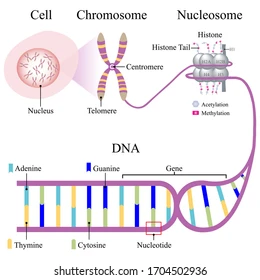
What is a gene?
A gene is a section of DNA that has specific instructions for making a particular molecule, usually a protein. Each dog has two copies of each gene, one inherited from its mother and the other from its father. These two genes may be identical or slightly different.
These different versions of the same gene are called alleles. These different genes contribute to the unique physical characteristics of each dog and explain the differences between each dog and breed.
There are about 19,000 protein-coding genes in the dog genome.
What is the function of a gene?
The genome of a dog (the sum of its genetic material) can be seen as a cookbook divided into chapters containing recipes. These recipes are the dog’s genes and the letters that make up each recipe are the DNA. Just as a recipe can be used to make a dish of food, a gene can be used to make a protein. Proteins are the building blocks of every organism and make up bones, teeth, hair, muscles, etc. Genes are therefore essential for the production of proteins that have an impact on the characteristics of a dog.
What is the function of an allele?
Each dog has two copies of each gene, one inherited from its mother and one from its father. These two genes may be identical or slightly different. Different versions of the same gene are called alleles and can result in variations in the protein that is produced, or where, when and how much protein is produced. These differences in the way the protein is produced contribute to the unique physical characteristics of each dog and explain the differences between each dog and breed.
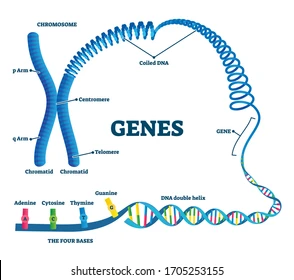
What is a chromosome?
Chromosomes are structures found inside the nucleus of a cell (the core of a cell) and are composed of DNA wrapped around proteins. The structure of a chromosome keeps DNA tightly packed and wound around spool-shaped proteins called histones. Without these structures, the DNA would be far too long to fit inside each cell. If unrolled and laid end to end, the DNA of a dog cell would be up to several feet long. For a dog to function, each cell must frequently divide and replace old cells with new ones. Chromosomes ensure that DNA is evenly distributed and accurately copied during cell division.
Each cell in a dog’s body contains 39 pairs of chromosomes.
reference :thekennelclub-org-uk
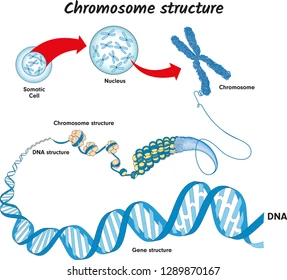
2 – The canine genome
A dog’s body contains billions of cells. Most of these cells contain a nucleus. In dogs, 38 pairs of autosomes (non-sex chromosomes) can be found in each nucleus, for a total of 76 chromosomes plus the two sex chromosomes (X and Y) for a grand total of 78. At conception, a dog obtains one copy of each chromosome from each parent. Chromosomes are made up of deoxyribonucleic acid (DNA), the “molecule of life”.
DNA is made up of small chemical building blocks called “nucleotides” or “bases”, which come in four types: adenine (A), guanine (G), cytosine (C) and thymine (T). All living organisms, including humans, use this four-letter code. The bases are paired in fixed units of adenine-thymine (AT) and guanine-cytosine (GC). Dogs have around three billion base pairs in each cell. Genes are defined by a unique sequence of nucleotides that can comprise as few as a hundred bases or as many as a million. The sequence of each gene is called its “code”. For example, the code for one gene may lead to proteins that add colour to the hair shaft, the code for another gene produces enzymes to digest food and a third gene will direct the formation of antibodies that fight disease. For a given gene, the code is very precise;
Each of the 78 chromosomes contains the codes for hundreds of genes. Genes code for the machinery needed to make proteins, which in turn make up the physical structure of the body. Proteins are necessary for all the body’s key systems, such as the nervous system and the digestive system. Each gene has a specific code which is passed on from parent to offspring. The term “canine genome” refers to the entire sequence of the dog genome, including all the genes and intervening spaces. Genes can determine how your dog will develop, from the colour of its coat to its personality traits and, in some cases, the diseases to which your dog will be susceptible.
reference :research-nhgri-nih-gov

Adapted from
DNA image from the NHGRI Intramural Publication Support Office, dog images with the
Courtesy of © AKC/Mary Bloom

Adapted from the NHGRI Intramural Publication blue DNA image
Support Office
II – Dog DNA
A dog’s colour is expressed through its DNA.
On this DNA, a part codes for the colour of the dog, this part is composed of locus :
- E Locus and B locus which code for its basic colour (black, brown, red, tan, etc.),
- D Locus which codes for diluted colour (blue, beige, sand, isabella,…),
- K Locus which codes for brindle and allows the A locus to be expressed or not,
- A Locus which codes for the charcoal and tanner,
- Em Locus which codes for the mask,
- S Locus which codes for white mottling,
- M Locus which codes for the marble motif.
The interpretation of the colours differs from breed to breed. So don’t be surprised if the “name” of the colours used does not quite match the one used in your dog breed. Genetically, it is about these colours.
Different interactions between colour locus
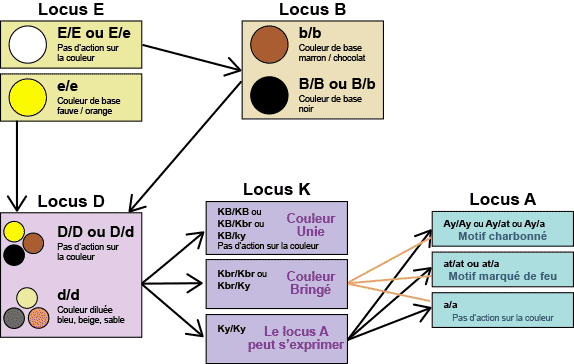
1 -Colour genetics in dogs
Terms used
Gene: segment of DNA located on the chromosomes. It determines the development of a phenotypic trait (i.e. visible in the animal).
Locus : location of the gene on the chromosome
Allele : version of the same gene, each dog has 2 alleles for each gene, each allele being inherited from one of its two parents.
Pigments
The coat of all existing dogs is coloured by just two types of pigment. Each has a default colour type, which can be modified by the action of several genes described below.
Eumelanin: by default, this is the black pigment
Pheomelanin: by default, this is the tawny pigment
The genes coding for coat colour in dogs determine both the colour of these two pigments and their distribution.
NB: When we talk about coat here, we’re talking not only about the colour of the hair but also that of the nose, mucous membranes, eyes, etc.
Transmission
Assume an A locus with two alleles, A and a.
Each dog has two alleles, so it can be : AA, Aa (or aA) or aa.
Let’s now try to find out the genotype (the distribution of alleles) of the puppies in a litter.
If the sire and dam are AA: all puppies will be AA
If both sire and dam are aa: all puppies will be aa
If the father is AA and the mother is Aa: 50% of the puppies will be AA and 50% will be Aa.
If the sire is AA and the dam is aa: 100% of puppies will be Aa
If the father is Aa and the mother is Aa: 50% of the puppies will be Aa, 25% will be AA and 25% will be aa.
By studying the colours of descendants, ascendants and collaterals, we can guess at least part of a dog’s genotype.
Genes
The genes coding for coat colour in dogs are named by capital letters.
There are 3 categories of genes: those coding for the base colour, those coding for the intensity of the colour, and those coding for the distribution of white areas.
NB: For each locus, the alleles will be presented from the most dominant to the most recessive.
Genes encoding the base colour
A Locus (Agouti)
This series determines which cells produce eumelanin on the hair.
-Ay (yellow): This allele codes for a fawn coat (ranging from red to sandy), with or without black hairs in the coat or black-tipped hairs.
Example : Akita Inu, Tervueren, Pug, …
aw (wolf) : is the “wolf grey” colour, which corresponds to hairs “bandaged” with eumelanin and pheomelanin.
Example : Siberian Husky, Czech Wolfdog, Grey German Shepherd,…
-at (Tan Points) : A colour generally known as “black and tan” or “tricolour” for certain breeds. The distribution of the “tan”, i.e. the “tan” marking, is well defined: lozenges above the eyes, the side of the muzzle coming down under the dog’s head, two triangles on the front of the chest, on the bottom of the pasterns and on the inside of the limbs and under the tail.
Example : Rottweiler, Tricolour Brittany Spaniel, Tricolour Border Collie,…
-a: The dog is totally black. This allele is fairly rare and only affects a few breeds. See the K locus for the colour “dominant black”.
Example : Black German Shepherd, Schipperke, Puli,…
B Locus (brown)
This is where the colour of the eumelanin, black or brown, is determined.
-B (black) : eumelanin retains its default colour, remaining black.
Example : Dobermann, Australian Shepherd, Newfoundland,…
Note that a dog with a B allele will not necessarily be black, just the eumelanin will be. Other genes determine how eumelanin is present in the coat.
Other examples of dogs with at least one B allele: Fawn Labrador, Irish Setter, Whippet
-b (brown) : the eumelanin produced is brown, all areas of the coat containing eumelanin are brown, including the coat, nose, mucous membranes, etc. The eyes are also lighter than in a dog with at least one B allele. The colour has many names: brown, chocolate, red, etc.
Example : Dobermann, Australian Shepherd, Newfoundland,…
E Locus (extension)
This series manages the presence or absence of masks, as well as the “recessive fawn” colour.
-Em: The dog has a mask, black or brown depending on the alleles in the B locus.
Example : German Shepherd Dog, American Akita, French Bulldog,…
-E: normal extension, no mask. The other loci can place eumelanin on the dog’s coat.
Example : Beauceron, Braque de Weimar, Parson Russell Terrier,…
-e: “Recessive fawn”, eumelanin cannot be produced in the dog’s coat regardless of the other alleles at the other loci. While the ‘recessive fawn’ is, as its name suggests, the most recessive allele in its series, it is dominant at the other loci. A recessive fawn dog cannot have even one black coat. The colour of its nose, mucous membranes, etc. will depend on the alleles of the B locus.
Example : Golden Retriever, Hungarian Braque, Clumber Spaniel,…
K Locus
This series gives expression to the dominant black and brindle.
-Kb (black) : Responsible for the dominant black, the dog is entirely black.
Example : Flat Coated Retriever, Chow Chow, Dogue Allemand,…
-Kbr (brindle) : Allows the expression of the brindle coat, i.e. the presence of bands of eumelanin on a background of pheomelanin.
Example: Dutch Shepherd, Cairn Terrier, Whippet,…
-ky (yellow) : lets the alleles at locus A express themselves.
Example : Malinois, Lakeland Terrier, Barzoï,…
Genes coding for colour intensity
D Locus (dilution)
-D: The pigments are not diluted
-d : Eumelanin is diluted from black to blue/grey and from brown to isabella/lilac. Dilution also affects the nose and mucous membranes, and the eyes are generally clear. To a lesser extent, the d allele may also have a diluting effect on pheomelanin.
Example : Cane Corso, Braque de Weimar, Thai Ridgeback,…
M Locus (marble)
-M: When a dog has a single M allele, it is said to be a marble or a harlequin, depending on the breed. This colour is characterised by a random dilution of certain sections of the coat, a grey/blue dilution when the base colour is black, for example. Only the eumelanin is affected by the marble.
Example : Border Collie, Beauceron, Welsh Corgi Cardigan, …
Warning: a dog homozygous for this locus, i.e. carrying 2 M alleles, will be called double-marble, i.e. merles with invasive white. Lack of pigmentation generally affects the eyes, nose and mucous membranes. Scientific studies have shown that double-marble dogs are highly susceptible to deafness and blindness. To prevent the production of such dogs, mating between blackbirds should not be allowed. (Note: no longer authorised since 2017).
-m : The dog is not marble.
Locus H (harlequin)
This recently discovered series is unique in that it only applies to dogs carrying at least one marble allele.
-H: the dog is said to be a “harlequin” (note that this colour does not correspond to that of the Beauceron or Dachshund), meaning that the areas diluted by the action of the marble gene are transformed entirely into white. As in the case of the marble gene, only one H allele is needed for a dog to be a harlequin.
Mating between two Harlequin dogs is forbidden by the FCI, as they are necessarily merles and could produce double marble (see above for this colour). Only the Great Dane seems to be affected by this gene.
G Locus (progressive greying)
This locus has not yet been identified by scientists on the dog’s chromosomes. It therefore consists of a supposition based on observations.
-G : The colour of a dog’s coat changes throughout its life. If its basic colour is black, it is born black and then becomes grey/white over time.
Examples : Bearded Collie, Poodle, Tibetan Terrier,…
-g : No progressive grey.
S Locus (spotting)
-S: The dog has no white markings. In most breeds, a puppy is born with a white spot on one end, most often on the chest, tail or tip of the legs. This phenomenon is not linked to the action of any particular allele, but rather to the order in which the pigments migrate, ending at the extremities. Delayed development could therefore cause these white spots.
-sp (piebald): The dog is white and has coloured spots (determined according to the other loci), more or less numerous and more or less extensive.
Example : Pointer, Jack Russell Terrier, English Springer Spaniel,…
These two alleles are the only ones to have been identified by DNA testing by scientists. The following are alleles that scientists assume exist but have yet to identify.
-sw (extreme white): The dog is almost entirely white with a few spots of colour.
Example : Bull Terrier, Epagneul Nain Continental Phalène, Greyhound,…
-si (irish spotting): The white is distributed on the dog’s lower legs, chest, neck (above and below, forming a “collar”) and muzzle, as well as the tip of the tail.
Example : Border Collie, Boston terrier, Basenji,…
Genes coding for the distribution of white zones
T Locus (ticking)
This locus has not yet been identified by scientists on the dog’s chromosomes. It therefore consists of a supposition based on observations.
-T: Ticking corresponds to coloured spots on white areas. It can therefore only be expressed if the dog has white zones, managed by the S locus.
Example : Border Collie, Braque Français, Cocker Spaniel,…
-tr (roan): The term roan can be translated as speckled. The speckles here correspond to very small traces of colour on white areas. At birth, the areas concerned are almost entirely white, with the mottled character appearing later.
Example : Australian Cattle Dog, Basset Bleu de Gascogne, German Pointer,…
Text by Lou, written in 2013 :
“I have included all the loci identified by the scientists or for which they have strong presumptions.
There are still a number of loci that are mentioned all over the place but which have never been identified. In particular, these locus concern the dilution of pheomelanin, from a simple dilution (Tervueren “grey”) to an extreme dilution, which some attribute to the White Shepherd or the Samoyed, for example. This is known as the I and C locus.
2 – Les différents Locus
E locus :
There are two forms of the gene at the E locus: the e gene and the E gene. The e gene codes for the so-called fawn colour and the E gene codes for the B locus.
Possible results:
- e/e:The basic colour of the dog is fawn (Labrador called Fauve, English Setter called Lemon, …
- E/e et E/E: It is up to the B locus to decide on the base colour
The E gene is dominant over the e gene. Indeed, when a dog is E/e then it is the E gene that dominates and rules. The E gene is called dominant and the e gene is called recessive.
- A dog passes on 50% of its DNA to its puppies.
- An e/e dog only passes on the e gene to its puppies.
- An E/e dog will therefore pass on the E gene or the e gene to its puppies. Fawn-carrying dog (e).
- An E/E dog only passes on the E gene to its puppies.
A puppy has two genes: one from the mother and one from the father. By knowing the locus of the parents, we can get an idea of the locus of the puppies.
B locus:
Note: The B locus is only expressed if the results of the E locus are E/E or E/e. The B locus is not expressed if the E locus is e/e.
There are two forms of the gene at the B locus: the b gene and the B gene. The b gene codes for the colour brown and the B gene codes for the colour black.
Possible results (with E/W or E/e):
- E/E b/b or E/e b/b Basic colour brown, Chocolate,…
- E/E B/b or E/e B/b Basic colour black (visible) with brown (genetic but not visible)
- E/E B/b or E/e B/b Basic colour black (visible) with brown (genetic but E/E B/B or E/e B/B Basic colour black visible)
The B gene is dominant over the b gene. Indeed, when a dog is B/b then it is the B gene that dominates and rules.
- A dog passes on 50% of its DNA to its puppies.
- A b/b dog can only pass on the b gene to its puppies.
- A B/b dog will therefore pass on the B gene or the b gene to its puppies. Brown carrier dog (b).
- A B/B dog can only pass on the B gene to its puppies.
D locus:
There are two forms of the gene at the D locus: the d gene and the D gene. The d gene codes for diluted colour and the D gene codes for undiluted colour.
Possible results:
- d/d Diluted colour: Blue, Beige, Sand, Isabella, …
- D/d Visible undiluted colour (but dilution carrier)
- D/D Undiluted colour
The D gene is dominant over the d gene. Indeed, when a dog is D/d then it is the D gene that dominates and rules.
If the dog has a tan base colour (e/e The B locus is not involved)
- d/d Colour Sand (Diluted Fawn), …
- D/d Visible tan colour (but dilution carrier)
- D/D Tan colour
If the dog’s basic colour is brown or chocolate (E/E b/b or E/e b/b):
- d/d Beige, Isabelle (diluted brown), …
- D/d Visible brown colour (but dilution carrier)
- D/D Brown colour
If the dog’s basic colour is black (E/E B/B or E/e B/B or E/E B/b or E/e B/b):
- d/d Colour Blue (diluted black), …
- D/d Colour black (but dilution carrier)
- D/D Black colour
- A dog passes on 50% of its DNA to its puppies.
- A d/d dog can only pass on the d gene to its puppies.
- A D/d dog will therefore pass on the D gene or the d gene to its puppies. Dilution carrier dog (d).
- A D/D dog can only pass on the D gene to its puppies
K locus:
There are three forms of gene at the K locus: the K gene, the Kbr gene and the Ky gene. The K gene does not change the colour of the dog, the Kbr gene codes for brindle colour and the Ky gene allows expression of the A locus.
Dominance rule : gene K > gene Kbr > gene Ky
Possible results:
- K/K ou K/Kbr ou K/Ky : No effect on dog colour, blocks expression of the A locus.
- Kbr/Kbr ou Kbr/Ky : Brindle colour, the A locus can be expressed
- Ky/Ky : the A locus can be expressed
- A dog passes on 50% of its DNA to its puppies.
- A K/K dog can only pass on the K gene to its puppies.
- A K/Kbr dog will therefore pass on the K gene or the Kbr gene to its puppies. Brindle carrier dog (Kbr).
- A K/Ky dog will therefore pass on the K or Ky gene to its puppies. Dog carrier of Ky.
- Kbr/Kbr dog can only pass on the Kbr gene to its puppies.
- Kbr/Ky dog wil therefore pass on the Kbr gene or the Ky gene to its puppies. Brindle dog carrying Ky.
- A Ky/Ky dog can only pass on the Ky gene to its puppies
Em locus :
The Em locus enables the mask to be expressed in many breeds of dog. The Em gene is dominant. If a copy of this gene is present, the dog will wear the mask.
If the dog has only one copy, it will statistically transmit the gene to 50% of its offspring.
If the dog has two copies of the gene, it will systematically transmit one copy of the Em gene.
A locus :
The A locus is only expressed if the K locus is Ky/Ky or Kbr/Kbr or Kbr/Ky. There are three common forms of gene at the A locus: the Ay gene, the
at gene and the a gene.
The Ay gene codes for the charcoal colour.
The at gene, which codes for the tricolour or fawn colour.
The a gene which codes does not change the colour of the dog.
Dominance rule : A gene > ay gene> at gene > a gene
Possible results:
- Ay/Ay or Ay/at or Ay/a : Charcoal colour,
- at/at or at/a : Marked tan, bicolore or tricolore,
- a/a : No effect on dog colour.
A dog passes on 50% of its DNA to its puppies.
- An Ay/Ay dog can only pass the Ay gene to its puppies. charcoal dog.
- An Ay/at dog will therefore pass on the Ay gene or at gene to its puppies. Charcoal hound carrying fire markings (at).
- An Ay/a dog will pass the Ay gene or the a gene to its puppies. Charcoal dog carrying the recessive gene a.
- An at/at dog can only pass the at gene to its puppies. Dog marked by fire.
- An at/a dog will pass the at gene or the a gene to its puppies. Fire-marked dog carrying recessive gene a.
- An a/ a dog can only pass on the a gene to its puppies.
reference : Génindexe.com
3 – The marble colour
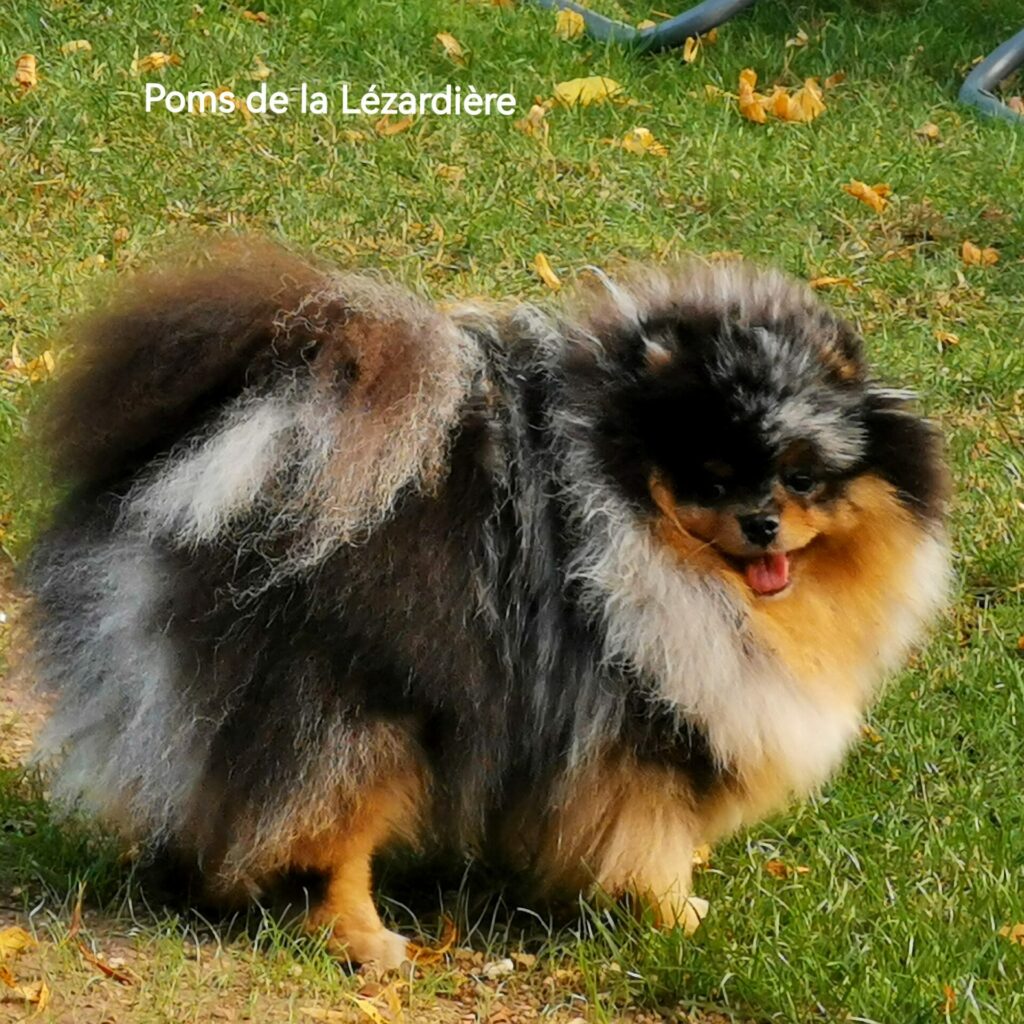
There are two different varieties of the marble coat:
- Blue marble: This coat has a predominantly blue ground colour, i.e. a mixture of black and white hairs and black spots. These spots can be small or very large and look like patches.
- Red marble: this type of merle dress has a wide range of colour variations. In this case, the dominant blue colour is replaced by a dominant liver colour.
In general, the majority of dogs that wear a marble coat have blue or minnow eyes, i.e. two different colours.
Dogs with a merle-type coat can be bred with breeds of other coat colours.
Remember that you should never mate two carriers of the marble gene.
They will give birth to double-marble puppies. It is important to know that the children will have a very high risk of developing blindness, deafness and malformations. The risk of mortality is high.
The SCC (Société Centrale Canine) banned these unions in 2017.
Animal Welfare Act: “Mating a marble with a marble is breeding under torture and is prohibited”.
It should be noted that some dogs carry the marble gene, but their coat colour does not show it, which is the famous “hidden coat”. These are known as cryptic merle dogs or ghost marble dogs. They carry the McMc or MMc genotype.
However, if these dogs breed with other marble or cryptic marble dogs, they are likely to produce puppies that are blind, deaf and/or malformed in the same way.
What is it?
Merle is a coat colour in dogs that is characterised by a dominant hue and diluted patches that blend in with the normal melanin. This characteristic is genetic and manifests itself from the birth of the puppies.
Thus, a dog whose coat is not marble coloured, and therefore not carrying this gene, will be of genotype mm.
In comparison, a dog with a marble coloured coat will have an Mm or mMc genotype.
What genetic statuses are possible?
There are 6 possible genetic statuses in dogs:
- The mm genotype or no-marble carrier: the dog has two normal copies of the SILV gene and therefore does not carry the marble coat.
- The mMc or cryptic marble carrier genotype: in this case, the dog has one normal and one hidden marble copy of the SILV gene. It therefore does not carry the blackbird colour, but it has a 50% chance of passing it on to its offspring, whether in a hidden version or not.
- The McMc or cryptic marble homozygote genotype: the dog has two hidden marble copies of the SILV gene. He therefore does not wear the marble coat, but he will pass it on 100% to his descendants, in a hidden version or not.
- The MMc genotype or cryptic marble carrier: the dog has one marble and one hidden marble copy of the gene. Thus, he wears the merle coat and has more than a 50% chance of passing on one or other of the marble coats to his offspring, in a hidden or unseen version.
- The Mm or heterozygous marble genotype: this dog has one normal and one marble copy of the gene. It carries the marble colour and can pass on the marble coat to 50% of its offspring.
- MM genotype or homozygous marble or double marble: in this case, the dog has two marble copies of the SILV gene. He is therefore a marble, with a large dominant white colour, and has a high risk of suffering from hearing and eye problems. It passes on its coat and disorders to 100% of its offspring.
III -Colour Matching Guidelines
In application of the modification of the standard published on 13/12/2019, established by the German Club and validated by the ICF, it seems necessary to bring the following clarifications:
• Removal of the previous tolerance for inter-variety mating.
Consequently, a dwarf must be mated to a dwarf; a small to a small; a medium to a medium.
The Gris-loup and Blanche varieties, because of their low number of animals, may be granted an exceptional and non-renewable derogation linked to the size of the breeding stock, on reasoned request to the President of the Breed Club.
This application shall be accompanied by the provision of SCC-registered DNA from both sires.
• For each of the varieties: dwarf, small or medium, the applicable rules of unions between colours are exclusively the following:
o White with White
o Black or Brown with Black or Brown
o Orange, Charcoal Orange, Sand, Charcoal Sand, Mottled, Black and Tan can be paired together.
Important note: Wolf-grey dogs should be mated with each other or with a sable or charcoal sable; they should not be mated with a dog of any other colour! (charcoal orange or not, variegated, black and tan).
reference : centrale.canine
Published 28/02/2021 –Updated 28/02/2021
IV – Going further
1 – Learn about genetics with Centrale Canine
modules e-learning
It’s an illustrated video lesson, about 5 minutes long, and all you have to do is click on the link to watch it.
These modules have been developed by the Centrale Canine training department with the support of our partner Royal Canin and Wolf Learning.. The content was written by the Health and Genetic Resources Department (Fleur-Marie Missant and Dr Ambre Jaraud-Courtin), with Pr Marie Abitbol, professor of genetics at VetAgroSup, and member of the SCC’s Scientific Committee.
The first module prepares you for the following 3 modules, which will explore the genetic determinism of coat colour.
The second module of the Centrale Canine e-learning course on coat colours. We take you on a journey to the heart of the dog’s coat to explore the metabolism that produces the different colours of coat: the pigments and their distribution in the different cells involved.
The third module of the Centrale Canine e-learning course on coat colours. You will discover all the genes that govern the expression of coat colour in dogs, using photos of dogs of different breeds.
The fourth module in Centrale Canine’s e-learning course on coat colours. You will learn how to use your knowledge of colours to predict the (possible) colours of the puppies in your future litters.
2 – heredity and genetics
To find out more about dog genetics, visit the Genodog website.
To help you better understand the mechanisms that govern heredity and genetic phenomena in the canine species, veterinary surgeons have produced a series of fact sheets explaining the basics of genetics, the different ways in which hereditary traits are passed on and the theory and practicalities of DNA testing.
genetique information :
Coat colour, tail length, digestive enzymes and hearing ability are all characteristics determined by the genetic information contained within our dogs’ cells. How are these characters governed? What form does this genetic information take?
different types of heredity :
The colour of a dog’s coat and the length of its muzzle are hereditary traits, inherited from the parents and passed on to the offspring. But these two characteristics, which can be defined as qualitative and quantitative respectively, are not heritable in the same way.
videos
Video by Maurício Braga
(veterinary surgeon since 1988 and lifelong breeder – he has practised in France and Brazil, in a career path that can be described as original)
Training presented by Labgenvet
“The basics of dog genetics. Whether you are a dog breeder or an animal lover, you will learn many fascinating things about the evolution of breeds, simple genetic diseases, inbreeding, DNA testing, and many other aspects of genetics”.
To be continued
What is double-coat?
How to brush your dog?
How to protect your dog from the summer heat?
What are dog moults?
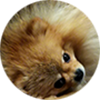
 by Lou – jeu 28 nov 2013
by Lou – jeu 28 nov 2013
